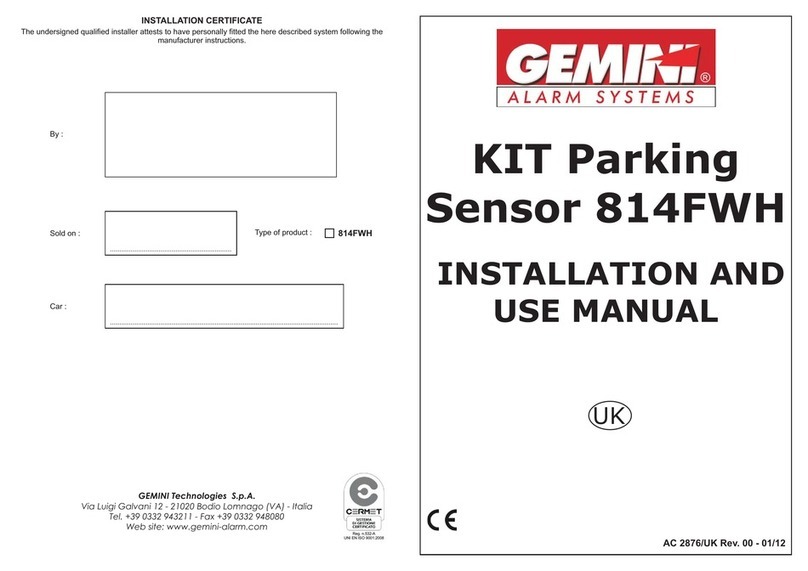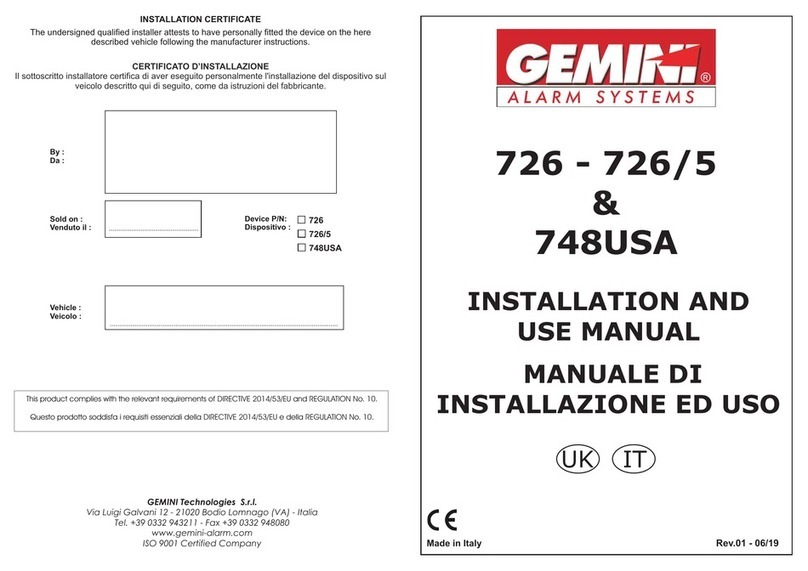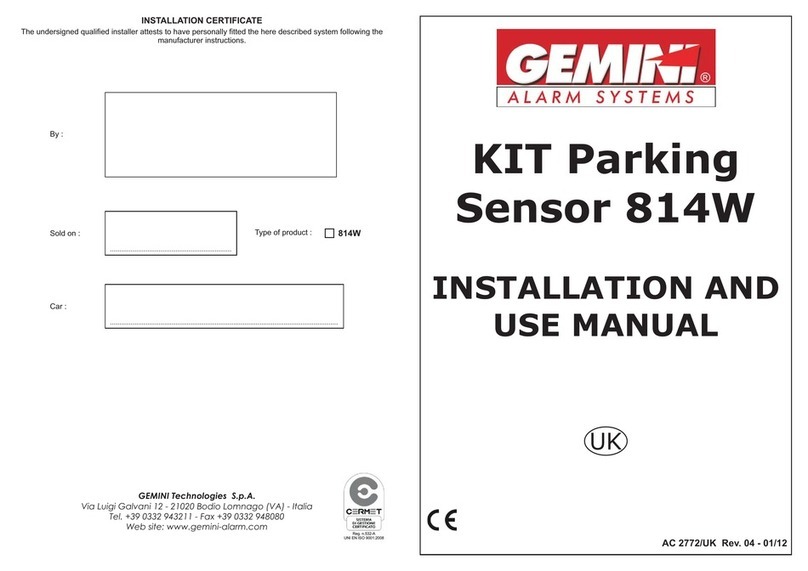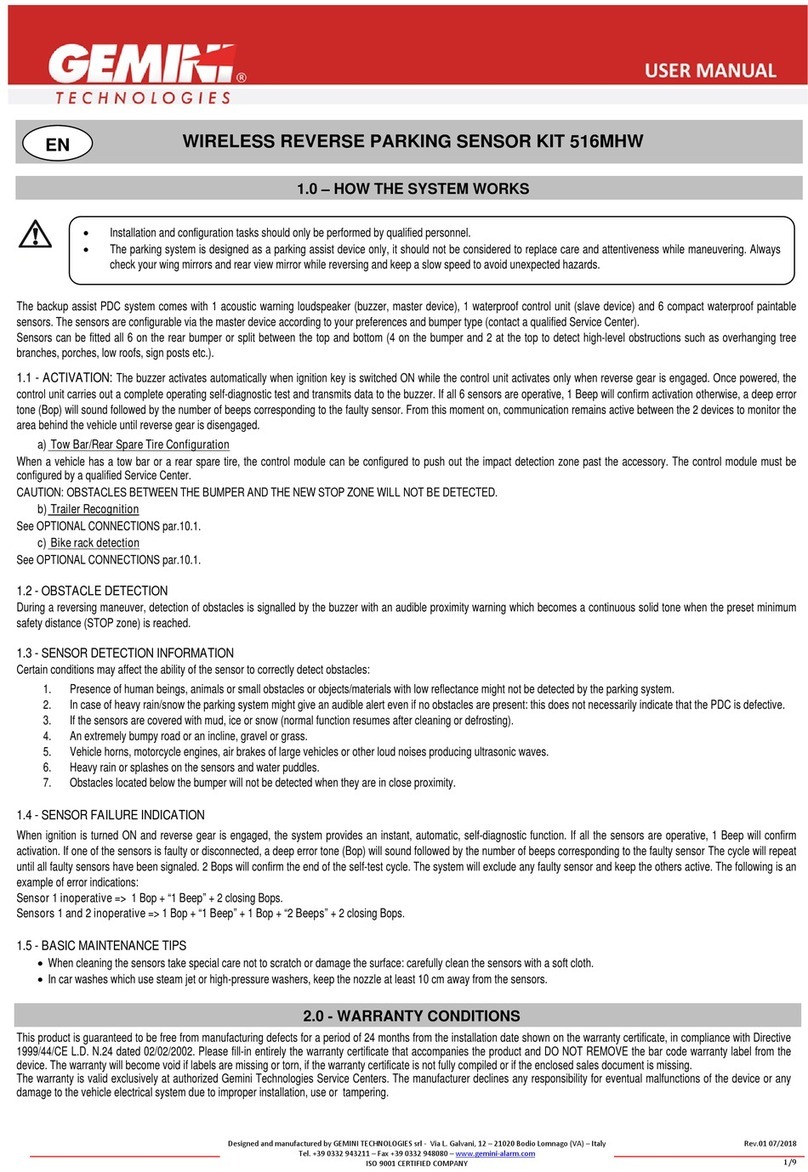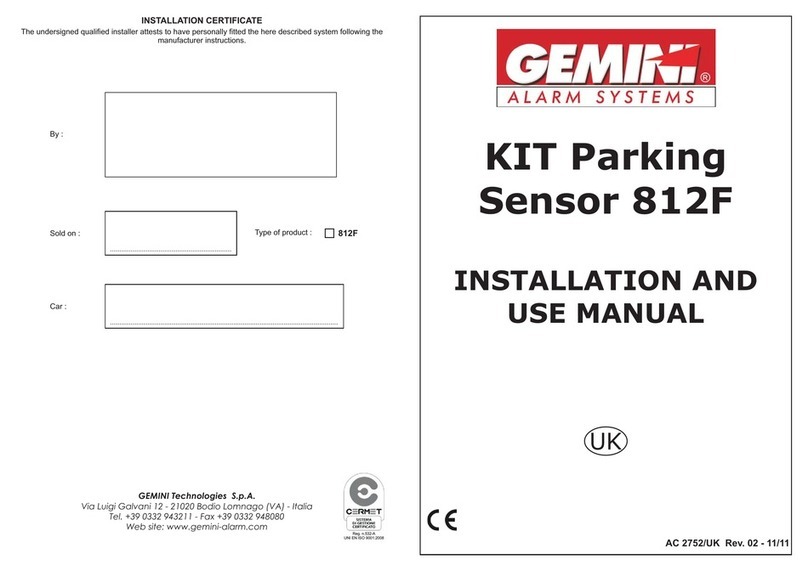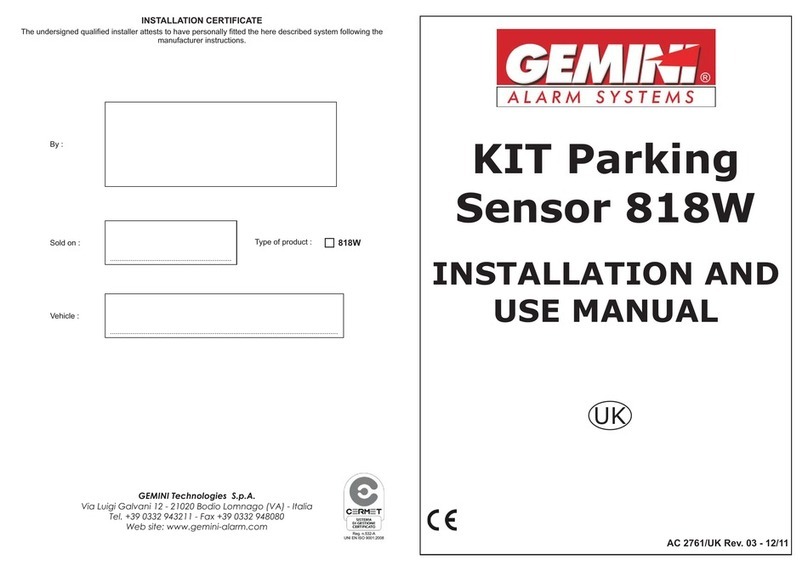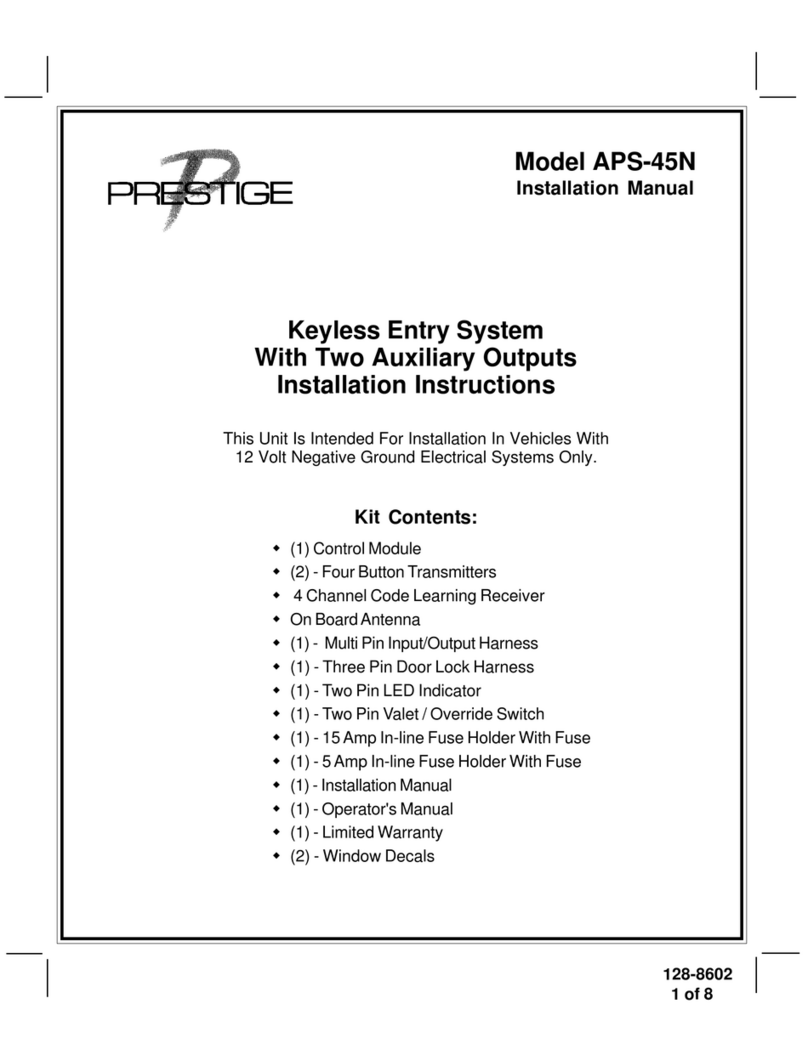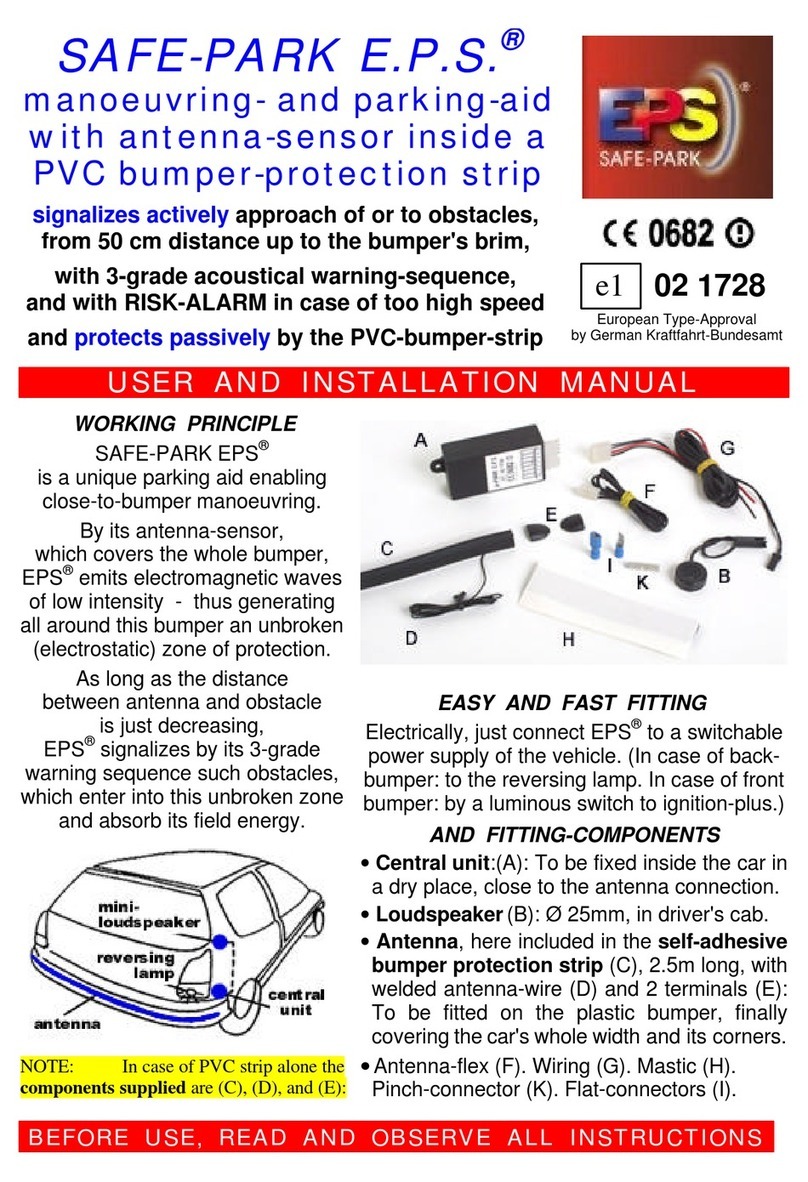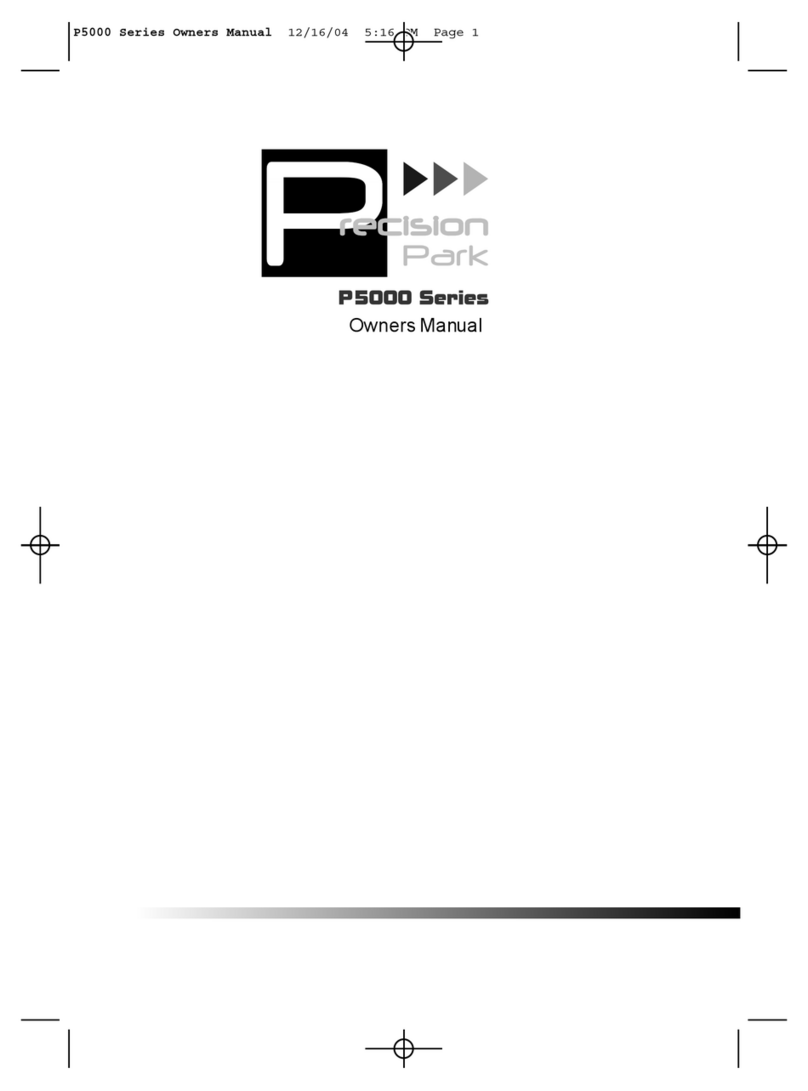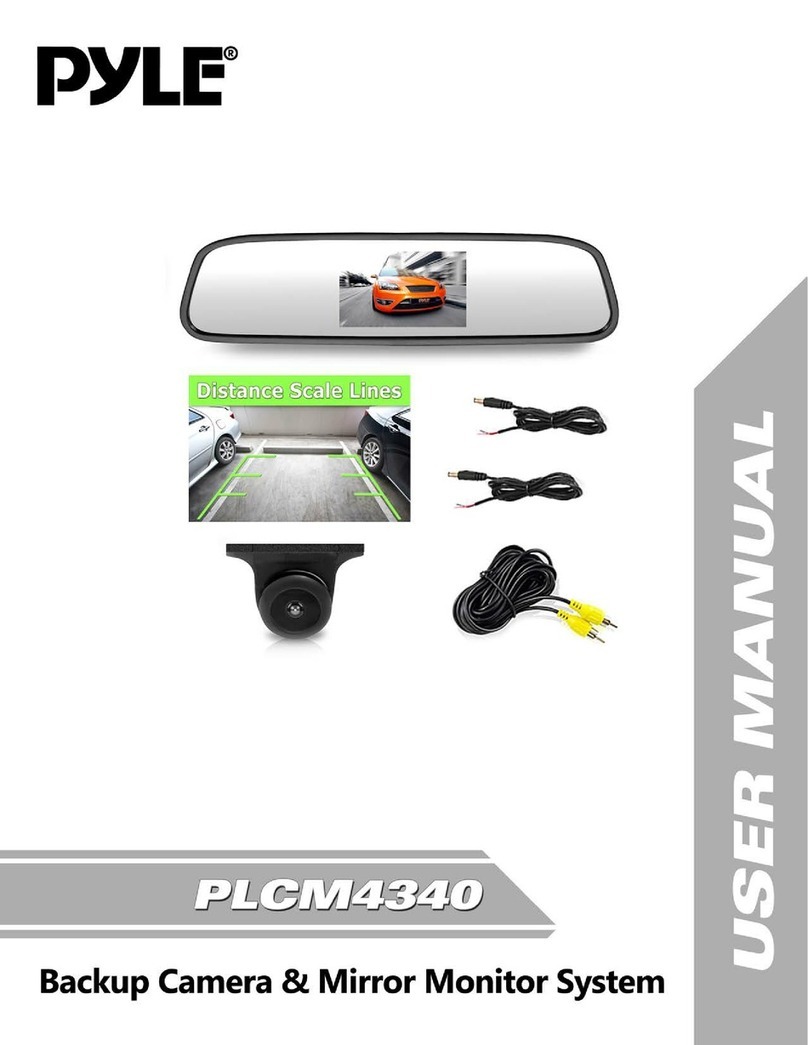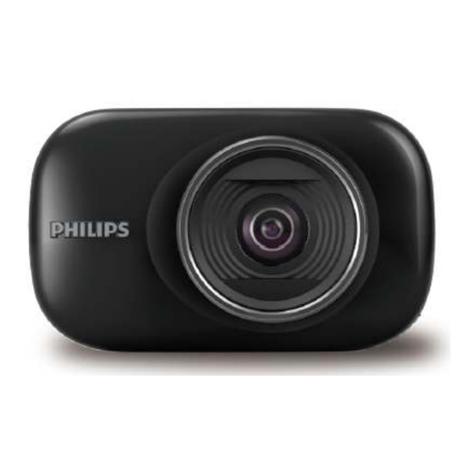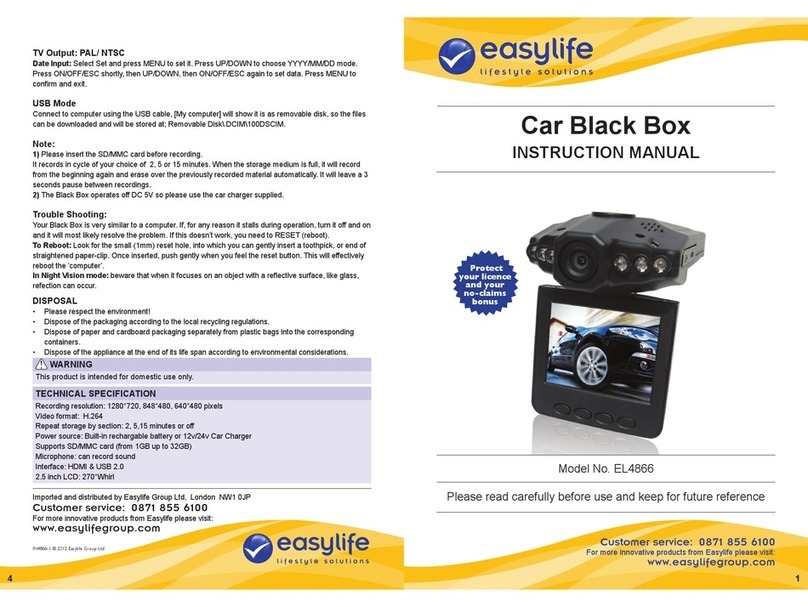Gemini 514 User manual

1/10 Rev.01 09/2015
The system comes with 4 compact waterproof sensors that can be spray painted to color match the shade of your bumper. The parking sensors can be
configured, by a Gemini authorized Service Center, to your preference and be set up so as not to be impeded by a rear mounted spare tire/tow bar.
The system is automatically activated when ignition is turned ON and reverse gear is engaged. Two consecutive beeps will confirm activation. Detection of
obstacles will be signaled by the buzzer. The audible warning with a series of beeps will increase in pitch and frequency as the vehicle moves nearer a stationary
object: the faster the beeping the closer the obstacle. The beeps become a continuous solid tone when the preset minimum safety distance (STOP zone) is
reached.
Tow Bar/Rear Spare Tire Configuration
When a vehicle has a tow bar or a rear spare tire, the control module can be configured to push out the impact detection zone past the accessory. The control
module must be configured by an authorized Service Center.
CAUTION: OBSTACLES BETWEEN THE BUMPER AND THE NEW STOP ZONE WILL NOT BE DETECTED.
Trailer Recognition
Trailer recognition mode automatically disables the rear sensors when towing with trailer plug connected (contact an authorized Service Center). When reverse
gear is engaged, 3 Bops will confirm deactivation of all sensors.
SENSOR DETECTION INFORMATION
Certain conditions may affect the ability of the sensor to correctly detect obstacles:
1. Presence of human beings, animals or small obstacles or objects/materials with low reflectance might not be detected by the parking system.
2. In case of heavy rain or snow the parking system might give an audible alert even if no obstacles are present: this does not necessarily indicate that
the parking system is defective.
3. If the sensors are covered with mud, ice or snow (normal function resumes after cleaning or defrosting).
4. An extremely bumpy road or an incline, gravel or grass.
5. Vehicle horns, motorcycle engines, air brakes of large vehicles or other loud noises producing ultrasonic waves.
6. Heavy rain or splashes on the sensors and water puddles.
7. Obstacles located below the bumper will not be detected when they are in close proximity.
BASIC MAINTENANCE TIPS
When cleaning the sensors take special care not to scratch or damage the surface: carefully clean the sensors with a soft cloth.
In car washes which use steam jet or high-pressure washers, keep the nozzle at least 10 cm away from the sensors.
SENSOR FAILURE INDICATION
When reverse gear is engaged, the parking sensor system provides an instant, automatic, self-diagnostic function. If all the sensors are operative, 2 Beeps will
confirm activation. If one of the sensors is faulty or disconnected, a deep error tone (Bop) will sound followed by the number of beeps corresponding to the faulty
sensor. The cycle will repeat until all faulty sensors have been signaled. 2 Bops will confirm the end of the self-test cycle.
The system will exclude any faulty sensor and keep the other ones active. The following is an example of error indications:
Sensor 1 inoperative => 2 activation Beeps + 1 Bop + 1 Beep + 2 closing Bops.
Sensors 1 and 2 inoperative => 2 activation Beeps + 1 Bop + 1 Beep + 1 Bop + 2 Beeps + 2 closing Bops.
This product is guaranteed to be free from manufacturing defects for a period of 24 months from the installation date shown on the warranty certificate, in
compliance with Directive 1999/44/CE L.D. N. 24 dated 02/02/2002.
Please fill-in entirely the warranty certificate that accompanies the product and DO NOT REMOVE the bar code warranty label from the device. The warranty will
become void if labels are missing or torn, if the warranty certificate is not fully compiled or if the enclosed sales document is missing.
The warranty is valid exclusively at authorized Gemini Technologies S.p.A. Service Centers.
The manufacturer declines any responsibility for eventual malfunctions of the device or any damage to the vehicle electrical system due to improper installation,
use or tampering.
WIRED REAR PARKING SENSOR KIT 514
WARRANTY CONDITIONS
U
K
HOW THE SYSTEM WORKS
Installation andconfiguration tasks should only be performed by qualified personnel.
The parking system is designed as a parking assist device only, it should not be considered to replace care and attentiveness while
maneuvering. Always check your wing mirrors and rear view mirror while reversing and keep a slow speed to avoid unexpected hazards.

2/10 Rev.01 09/2015
Ø 18-20mm
Sensors and adapters can be spray painted before assembly to match the color of the vehicle (optional). To spray paint proceed as follows:
1. Use isopropyl alcohol to clean the sensors and the adapters and let dry. Avoid touching the cleaned surfaces.
2. Insert the selected adapters in the supplied cardboard template:
Center adapters => fully insert into the cardboard template slots from the top side.
Outer adapters => press halfway down the slots, up to the side tabs, from the top side.
3. The sensors must be inserted in the central slots from underneath the cardboard. For a perfect spray-paint finish, we recommend turning down
the black silicone seal around the sensor head before inserting the sensor into the slots (paint might not adhere to the silicone).
4. Fold the cardbox template into a box. Spray paint the sensors and the adapters and let dry thoroughly before assembling.
NB: Too much spray paint can impair the sensors performance.
4x sensors
1x buzzer
1x control unit
(
ECU
)
4x cable clips
10x zi
p
-ties
4x 10° angled
external adapters 4x standard external
adapters 4x 10°angled inner
adapters 4x standard inner
ada
p
ters 8x adhesive pads
1x wire harness
KIT CONTENTS
TOOLS
SPRAY PAINT - SENSOR HEADS AND ADAPTERS
WIRED REAR PARKING SENSOR KIT 514

3/10 Rev.01 09/2015
System performance will depend on the correct positioning and angling of the sensors.
1. Accurately calculate and mark the sensor positions on the rear bumper using the guidelines set below.
2. Remove the bumper and make sure there are no obstructions that may hinder the fitting of the sensor heads.
3. Use the small diameter bit to drill pilot holes for each sensor.
4. Finish the holes to the proper diameter using the cone drill bit that matches the diameter of the selected adapters.
Installation and connections should only be done by qualified personnel.
Disconnect the negative pole of the battery before connecting any wire.
Some bumpers have factory markings on the inner side; before drilling any holes, make sure they correspond to the
recommended positions.
Some bumpers require correction adapters around the sensors to obtain the proper fitting angle.
40 - 50 cm 15-20 cm
15-20 cm
H 40 - 55 cm
90°100°
35 - 55 cm 35 - 55 cm
80°
INSTALLATION PRECAUTIONS
PREPARING FOR INSTALLATION
IDEAL SENSOR SPACING AND HEIGHT
90°

4/10 Rev.01 09/2015
1. Control unit and buzzer
Position the control unit in the luggage compartment, in a dry place, away from water infiltrations.
Mount the buzzer with the supplied double-faced adhesive tape or screws where the driver will clearly hear the audible signals.
Find a factory grommet in the rear of the vehicle. Feed the sensor wires through the grommet and route them outside of the vehicle.
2. Sensors
The parking sensors can be fitted either from the inside of the bumper (Fig. A) or from the outside (Fig. B) with the specific snap-in adapters.
a)
Installation on the inside of the bumper:
1. Clean and degrease around the fitting holes.
2. Choose the suitable type of adapters according to the bumper shape:
Standard (Ø 18mm hole)
Angled 10° (Ø 20mm hole) to correct the angle of the sensor heads on bumpers that curve up or down.
3. Peel off the adhesive film on one side of the adapter pad and apply on the front side of the adapter as illustrated below.
4. Peel off the remaining adhesive liner and align the adapters on the 4 holes previously drilled in the bumper.
5. Clip the sensors into the adapters with the arrows and the UP indication facing upwards.
A
lignment mark on top
UP
INSTALLATION
A
B

5/10 Rev.01 09/2015
6. Connect the sensors to the wires coming out of the trunk (the longest wires at the opposite end of the factory grommet).
SENSOR POSITIONING
7. Space out the supplied adhesive cable clips along the bumper, insert the cable ties and secure the wires in place. Bundle up any excess cables.
NB: Keep all wires away from high temperature components (ex. exhaust pipe).
8. Put the bumper back in place without bolting it up.
b)
Installation on the outside of the bumper:
1. Choose the suitable type of adapters according to the bumper shape and drill Ø 20mm holes for both types of adapters.
2. Press down the standard or angled adapters in place on the outer side of the bumper and proceed as indicated above for the inner installation,
from step 5.
1. RED wire: connect to +12V reverse backup light. The rear sensors will automatically turn ON when the vehicle is put in reverse.
2. BROWN wire: connect to the vehicle chassis ground.
3. BLACK/BLACK buzzer connector: connect to the corresponding counterpart on the control unit (see wiring diagram).
4. BLUE wire: by grounding this wire the rear sensors can be disabled when towing. The system can also be made to disable automatically by
connecting the trailer plug (if a free pin is available for electrical ground).
5. BLACK/RED wire connector: connect to configure the parking system via computer.
NB: These connections should be soldered.
ELECTRICAL CONNECTIONS

6/10 Rev.01 09/2015
PARKING SYSTEM AUDIBLE SIGNALS
When reverse gear is engaged, the parking sensor system provides an instant, automatic, self-diagnostic function. If all the sensors are operative, 2 Beeps will
confirm activation.
In case one of the sensors is faulty or disconnected, a deep error tone (Bop) will sound followed by the number of beeps corresponding to the faulty sensor. The
cycle will repeat until all faulty sensors have been signaled. 2 Bops will confirm the end of the self-test cycle.
The system will exclude any faulty sensor and keep the others active. The following is an example of error indications:
Sensor 1 inoperative => 2 activation Beeps + 1 Bop + 1 Beep + 2 closing Bops.
Sensors 1 and 2 inoperative => 2 activation Beeps + 1 Bop + 1 Beep + 1 Bop + 2 Beeps + 2 closing Bops.
CHECK AFTER INSTALLATION
1. Connect the negative cable to the battery and check operation of all lights and other electrical accessories.
2. Turn ignition key ON and engage reverse gear. Activation will be confirmed by 2 Beeps.
3. Test the sensors oneby one for detection by moving different obstacle simulators behind the vehicle. The system should beep according to the warning
zones.
NB: If necessary, modify the sensitivity setting (see parameter setup table).
4. If the parking sensors are working correctly, secure the bumper in place.

7/10 Rev.01 09/2015
System configuration is done by pressing buttons “A” and “B” (see figure below) or via a user-friendly PC software:
Press button “A” to select the parameter to configure.
Press button “B” to select the desired setting.
How to enter in programming mode:
1. Turn ignition ON and engage reverse gear.
2. Simultaneously press buttons “A” and “B” to enter in programming mode.
3. Operation will be confirmed by 1 Beep and 1 Red/Green LED flash.
4. Wait until the LED turns OFF.
Parameter setup:
1. Within 10 sec. after the LED turns OFF, press button “A” the number of times corresponding to the number of the parameter to customize. After
each button press there will be 1 Beep and 1 Red LED blink.
2. Press button “B” the number of times corresponding to the desired setup. After each button press there will be 1 Beep and 1 Green LED blink.
Example: To set the maximum detection distance of the inner sensors at 125 cm => press button “A” twice and then button “B” 7 times.
Setup confirmation:
1. The control unit will repeat the number of beeps and blinks corresponding to the selected setup. After a few seconds, if the code has been
successfully entered, the buzzer will give off a long beep (Beep, Beep, Beep) and the system will automatically exit the procedure.
2. If the entry is incorrect, the buzzer will emit a low tone signal (Bop) and automatically exit the procedure.
3. After the confirmation Beeps, other parameters can be configured by following the same procedure.
4. If no button is pressed within approx.10 sec., the system automatically exits programming mode.
Restore factory settings
a) Procedure A
1. Before engaging reverse gear, simultaneously press and hold buttons “A” and “B”; turn ignition ON and engage reverse gear.
2. The LED will start blinking Red/Green.
3. When the buzzer gives off a Beep, release buttons “A” and “B”.
4. When the LED stops blinking, the systemis reset to the original factory settings.
b) Procedure B
1. Disconnect the connector from the unit.
2. Turn ignition key ON and engage reverse gear.
3. Simultaneously press and hold buttons “A” and “B” and reconnect the connector.
4. The LED will start blinking Red/Green.
5. When the buzzer gives off a Beep, release buttons “A” and “B”.
6. When the LED stops blinking, the systemis reset to the original factory settings.
Before configuring the parking sensors, ensure all connections have been done properly.
Parameters must onl
y
be confi
g
ured b
y
q
ualified
p
ersonnel.
Button B
LED
PARAMETER SET-UP
Button A

8/10 Rev.01 09/2015
Programming can be done using the 2 buttons on the control unit or via a user-friendly PC software.
Programmable parameters Button
A Button
B Settings Default
settings
Buttons & PC PC only*
Sensitivity 1
1
Low
High
2
Medium
3
High
Buzzer volume 1
7
Low
High
8
High
STOP zone => Inner Sensors 2
1
30 cm
35 cm
50 cm
2
40 cm
45 cm
3
50 cm
55 cm
MAXIMUM distance => Inner Sensors
2
6
100 cm
180 cm
7
125 cm
8
150 cm
9
180 cm
STOP zone => Outer Sensors
3
1
30 cm
35 cm
40 cm
2
40 cm
45 cm
3
50 cm
MAXIMUM distance => Outer Sensors 3
5
60 cm
65 cm
80 cm
6
70 cm
75 cm
7
80 cm
8
100 cm
150 cm
180 cm
Rear spare tire or tow bar intelligent detection
(allows the system to see past the obstruction)
4
1
0
0
2
10 cm
3
20 cm
4
30 cm
* A user friendly PC software (soon available at: www.gemini-alarm.com) will allow more flexibility in programming the parameters. The dedicated interface
will also allow reading and overwriting previously configured parameters.
PARAMETER CONFIGURATION TABLE

9/10 Rev.01 09/2015
*Presence of human beings, animals or small obstacles or objects/materials with low reflectance might not be detected by the parking system.
.
Correct Position: height, inclination and
orientation are correct.*
Sensors fitted too low => false alarms due
to ground detection.
Sensors are excessively turned upwards
=> low obstacles are not detected.
Sensors are excessively turned
downwards => false alarms due to ground
detection.
Sensors fitted too high => low obstacles are
not detected.
Sensors have been properly fitted but the
vehicle weight has changed => the
performance of the parking system is affected
b
y
the added wei
g
ht.
√
X
X
X
X
!
SENSOR FITTING AND OBSTACLE DETECTION

10/10 Rev.01 09/2015
FAULTS CAUSE / SOLUTIONS
The system does not work when reverse gear is
engaged.
Check that the cable connectors from the sensors are correctly fitted to the control unit.
Check that the arrow and the UP indication are pointing upwards.
The sensors may have received an impact.
A sound signal goes off when there is no obstacle
at the rear of the vehicle.
Ensure that the sensors have been installed at the correct height.
If they read the ground, use the correction adapters to tilt the sensors upwards.
If the sensors detect the rear spare tire, modify setting.
Sensitivity might be too high. Adjust sensitivity.
Check that there is no excessive paint on the sensor surface. Too much spray paint can impair sensor ability to function
properly.
No signal is received when reverse gear is
engaged.
Check that the control unit is correctly connected to the reverse gear light.Check the sensor connections.
The buzzer does not sound. Check the connection between the unitand the buzzer.
Back part of sensors in contact with frame.
Create a separation between the sensors and the vehicle chassis (at least2mm)
The present device does not fall within the scope of Directive 2002/96EC on Waste Electrical and Electronic Equipment (WEEE) as specified in art. 2.1 of L. D.
No. 151 of 25/07/2005.
Power supply 12 - 24 Vdc
Current consumption 10mA @12V
Operating temperature range -40°C / +85°C
Ultrasonic frequency 58 KHz
TECHNICAL SPECIFICATIONS
TROUBLESHOOTING
WASTE ELECTRICAL AND ELECTRONIC EQUIPMENT (WEEE) DIRECTIVE
Table of contents
Other Gemini Automobile Electronic manuals

